Sustainable Tourism Development in the Philippines: A Detailed Report
VerifiedAdded on 2020/07/22
|16
|4396
|47
Report
AI Summary
This report provides a comprehensive analysis of sustainable tourism development in the Philippines. It begins by exploring the benefits for stakeholders in tourism planning and the advantages and disadvantages of public-private partnerships in this sector. The report then delves into the features of tourism development planning at international, national, regional, and sub-regional levels, emphasizing the significance of interactive planning systems and processes. It examines various methods for measuring tourist impact, including economic, social, and environmental measures. The report further introduces the concept of sustainability in tourism development, highlighting factors that may hinder sustainable practices. It also touches upon the different stages of planning for sustainability. The report emphasizes the need for a balanced approach, addressing both the positive and negative impacts of tourism and providing insights into creating a more sustainable and responsible tourism industry in the Philippines. The report also includes analysis of the current scenario in Philippines tourism sector.

SUSTAINABLE TOURISM
Paraphrase This Document
Need a fresh take? Get an instant paraphrase of this document with our AI Paraphraser
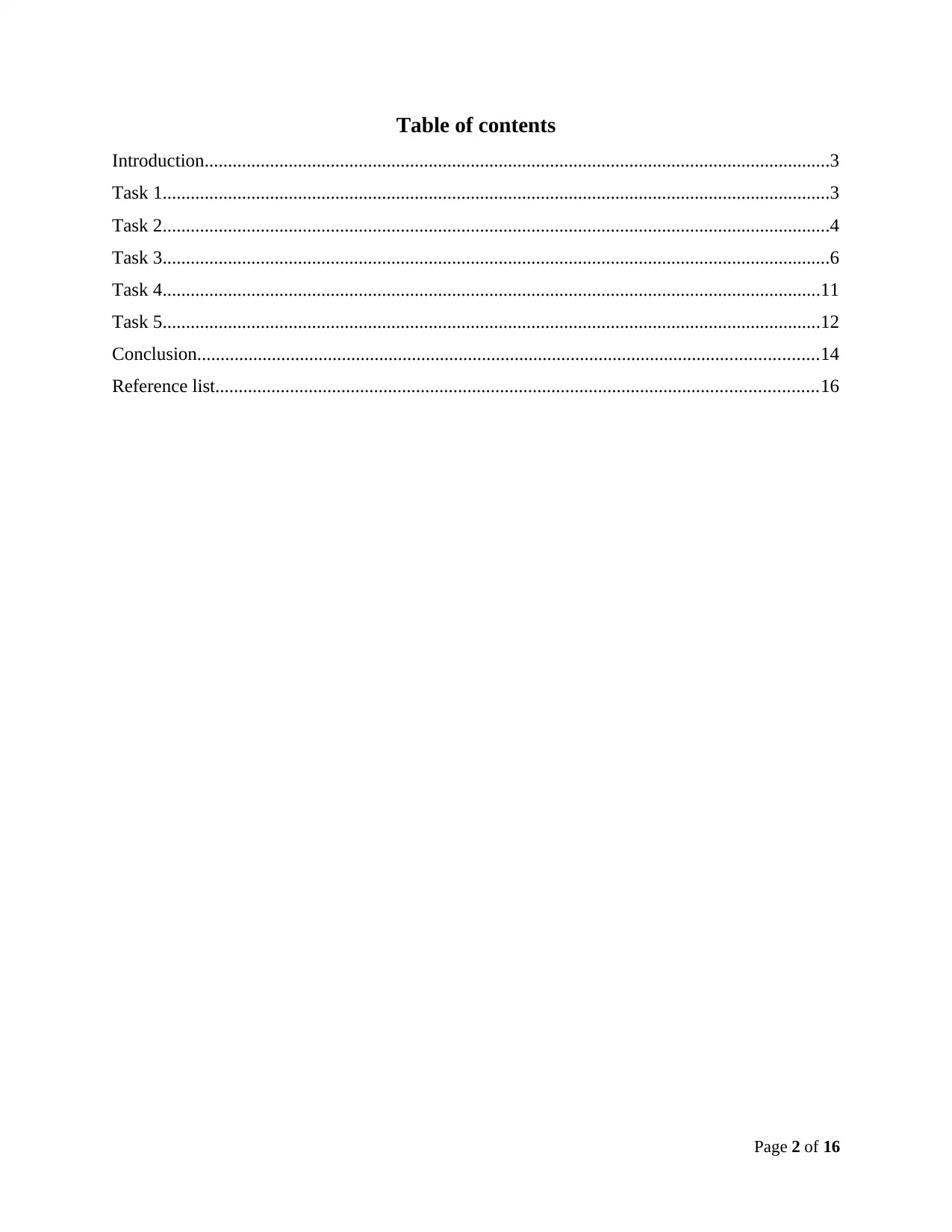
Table of contents
Introduction......................................................................................................................................3
Task 1...............................................................................................................................................3
Task 2...............................................................................................................................................4
Task 3...............................................................................................................................................6
Task 4.............................................................................................................................................11
Task 5.............................................................................................................................................12
Conclusion.....................................................................................................................................14
Reference list.................................................................................................................................16
Page 2 of 16
Introduction......................................................................................................................................3
Task 1...............................................................................................................................................3
Task 2...............................................................................................................................................4
Task 3...............................................................................................................................................6
Task 4.............................................................................................................................................11
Task 5.............................................................................................................................................12
Conclusion.....................................................................................................................................14
Reference list.................................................................................................................................16
Page 2 of 16
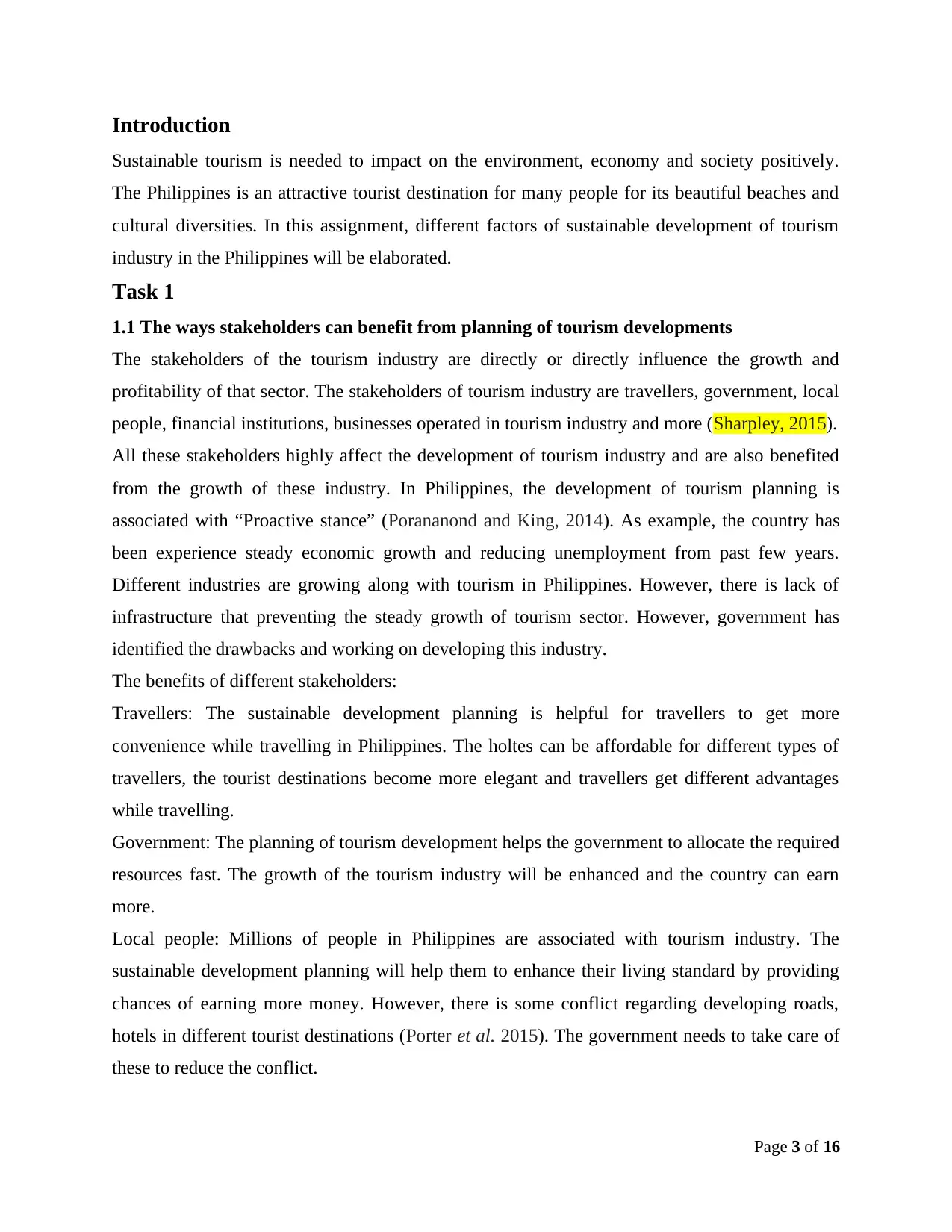
Introduction
Sustainable tourism is needed to impact on the environment, economy and society positively.
The Philippines is an attractive tourist destination for many people for its beautiful beaches and
cultural diversities. In this assignment, different factors of sustainable development of tourism
industry in the Philippines will be elaborated.
Task 1
1.1 The ways stakeholders can benefit from planning of tourism developments
The stakeholders of the tourism industry are directly or directly influence the growth and
profitability of that sector. The stakeholders of tourism industry are travellers, government, local
people, financial institutions, businesses operated in tourism industry and more (Sharpley, 2015).
All these stakeholders highly affect the development of tourism industry and are also benefited
from the growth of these industry. In Philippines, the development of tourism planning is
associated with “Proactive stance” (Porananond and King, 2014). As example, the country has
been experience steady economic growth and reducing unemployment from past few years.
Different industries are growing along with tourism in Philippines. However, there is lack of
infrastructure that preventing the steady growth of tourism sector. However, government has
identified the drawbacks and working on developing this industry.
The benefits of different stakeholders:
Travellers: The sustainable development planning is helpful for travellers to get more
convenience while travelling in Philippines. The holtes can be affordable for different types of
travellers, the tourist destinations become more elegant and travellers get different advantages
while travelling.
Government: The planning of tourism development helps the government to allocate the required
resources fast. The growth of the tourism industry will be enhanced and the country can earn
more.
Local people: Millions of people in Philippines are associated with tourism industry. The
sustainable development planning will help them to enhance their living standard by providing
chances of earning more money. However, there is some conflict regarding developing roads,
hotels in different tourist destinations (Porter et al. 2015). The government needs to take care of
these to reduce the conflict.
Page 3 of 16
Sustainable tourism is needed to impact on the environment, economy and society positively.
The Philippines is an attractive tourist destination for many people for its beautiful beaches and
cultural diversities. In this assignment, different factors of sustainable development of tourism
industry in the Philippines will be elaborated.
Task 1
1.1 The ways stakeholders can benefit from planning of tourism developments
The stakeholders of the tourism industry are directly or directly influence the growth and
profitability of that sector. The stakeholders of tourism industry are travellers, government, local
people, financial institutions, businesses operated in tourism industry and more (Sharpley, 2015).
All these stakeholders highly affect the development of tourism industry and are also benefited
from the growth of these industry. In Philippines, the development of tourism planning is
associated with “Proactive stance” (Porananond and King, 2014). As example, the country has
been experience steady economic growth and reducing unemployment from past few years.
Different industries are growing along with tourism in Philippines. However, there is lack of
infrastructure that preventing the steady growth of tourism sector. However, government has
identified the drawbacks and working on developing this industry.
The benefits of different stakeholders:
Travellers: The sustainable development planning is helpful for travellers to get more
convenience while travelling in Philippines. The holtes can be affordable for different types of
travellers, the tourist destinations become more elegant and travellers get different advantages
while travelling.
Government: The planning of tourism development helps the government to allocate the required
resources fast. The growth of the tourism industry will be enhanced and the country can earn
more.
Local people: Millions of people in Philippines are associated with tourism industry. The
sustainable development planning will help them to enhance their living standard by providing
chances of earning more money. However, there is some conflict regarding developing roads,
hotels in different tourist destinations (Porter et al. 2015). The government needs to take care of
these to reduce the conflict.
Page 3 of 16
⊘ This is a preview!⊘
Do you want full access?
Subscribe today to unlock all pages.

Trusted by 1+ million students worldwide
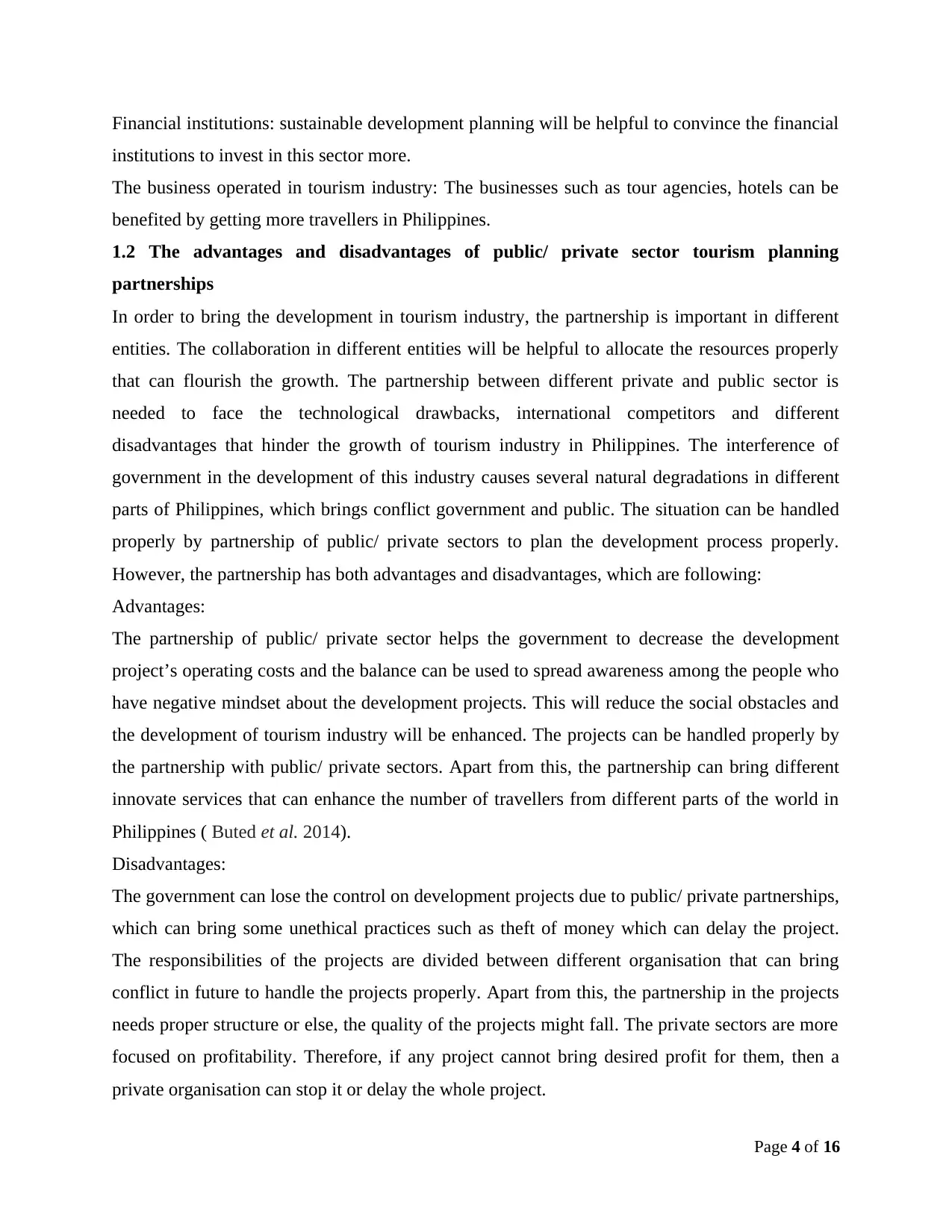
Financial institutions: sustainable development planning will be helpful to convince the financial
institutions to invest in this sector more.
The business operated in tourism industry: The businesses such as tour agencies, hotels can be
benefited by getting more travellers in Philippines.
1.2 The advantages and disadvantages of public/ private sector tourism planning
partnerships
In order to bring the development in tourism industry, the partnership is important in different
entities. The collaboration in different entities will be helpful to allocate the resources properly
that can flourish the growth. The partnership between different private and public sector is
needed to face the technological drawbacks, international competitors and different
disadvantages that hinder the growth of tourism industry in Philippines. The interference of
government in the development of this industry causes several natural degradations in different
parts of Philippines, which brings conflict government and public. The situation can be handled
properly by partnership of public/ private sectors to plan the development process properly.
However, the partnership has both advantages and disadvantages, which are following:
Advantages:
The partnership of public/ private sector helps the government to decrease the development
project’s operating costs and the balance can be used to spread awareness among the people who
have negative mindset about the development projects. This will reduce the social obstacles and
the development of tourism industry will be enhanced. The projects can be handled properly by
the partnership with public/ private sectors. Apart from this, the partnership can bring different
innovate services that can enhance the number of travellers from different parts of the world in
Philippines ( Buted et al. 2014).
Disadvantages:
The government can lose the control on development projects due to public/ private partnerships,
which can bring some unethical practices such as theft of money which can delay the project.
The responsibilities of the projects are divided between different organisation that can bring
conflict in future to handle the projects properly. Apart from this, the partnership in the projects
needs proper structure or else, the quality of the projects might fall. The private sectors are more
focused on profitability. Therefore, if any project cannot bring desired profit for them, then a
private organisation can stop it or delay the whole project.
Page 4 of 16
institutions to invest in this sector more.
The business operated in tourism industry: The businesses such as tour agencies, hotels can be
benefited by getting more travellers in Philippines.
1.2 The advantages and disadvantages of public/ private sector tourism planning
partnerships
In order to bring the development in tourism industry, the partnership is important in different
entities. The collaboration in different entities will be helpful to allocate the resources properly
that can flourish the growth. The partnership between different private and public sector is
needed to face the technological drawbacks, international competitors and different
disadvantages that hinder the growth of tourism industry in Philippines. The interference of
government in the development of this industry causes several natural degradations in different
parts of Philippines, which brings conflict government and public. The situation can be handled
properly by partnership of public/ private sectors to plan the development process properly.
However, the partnership has both advantages and disadvantages, which are following:
Advantages:
The partnership of public/ private sector helps the government to decrease the development
project’s operating costs and the balance can be used to spread awareness among the people who
have negative mindset about the development projects. This will reduce the social obstacles and
the development of tourism industry will be enhanced. The projects can be handled properly by
the partnership with public/ private sectors. Apart from this, the partnership can bring different
innovate services that can enhance the number of travellers from different parts of the world in
Philippines ( Buted et al. 2014).
Disadvantages:
The government can lose the control on development projects due to public/ private partnerships,
which can bring some unethical practices such as theft of money which can delay the project.
The responsibilities of the projects are divided between different organisation that can bring
conflict in future to handle the projects properly. Apart from this, the partnership in the projects
needs proper structure or else, the quality of the projects might fall. The private sectors are more
focused on profitability. Therefore, if any project cannot bring desired profit for them, then a
private organisation can stop it or delay the whole project.
Page 4 of 16
Paraphrase This Document
Need a fresh take? Get an instant paraphrase of this document with our AI Paraphraser
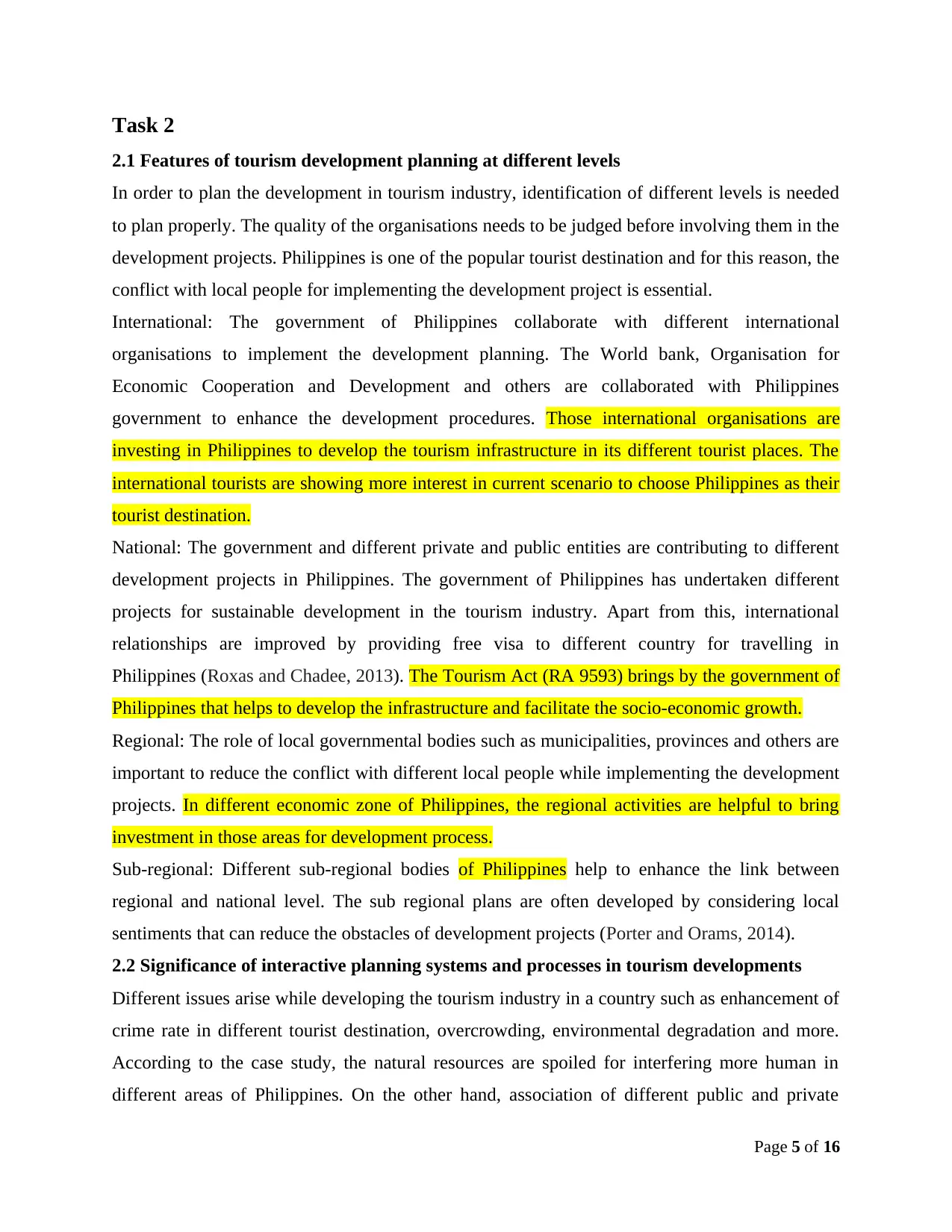
Task 2
2.1 Features of tourism development planning at different levels
In order to plan the development in tourism industry, identification of different levels is needed
to plan properly. The quality of the organisations needs to be judged before involving them in the
development projects. Philippines is one of the popular tourist destination and for this reason, the
conflict with local people for implementing the development project is essential.
International: The government of Philippines collaborate with different international
organisations to implement the development planning. The World bank, Organisation for
Economic Cooperation and Development and others are collaborated with Philippines
government to enhance the development procedures. Those international organisations are
investing in Philippines to develop the tourism infrastructure in its different tourist places. The
international tourists are showing more interest in current scenario to choose Philippines as their
tourist destination.
National: The government and different private and public entities are contributing to different
development projects in Philippines. The government of Philippines has undertaken different
projects for sustainable development in the tourism industry. Apart from this, international
relationships are improved by providing free visa to different country for travelling in
Philippines (Roxas and Chadee, 2013). The Tourism Act (RA 9593) brings by the government of
Philippines that helps to develop the infrastructure and facilitate the socio-economic growth.
Regional: The role of local governmental bodies such as municipalities, provinces and others are
important to reduce the conflict with different local people while implementing the development
projects. In different economic zone of Philippines, the regional activities are helpful to bring
investment in those areas for development process.
Sub-regional: Different sub-regional bodies of Philippines help to enhance the link between
regional and national level. The sub regional plans are often developed by considering local
sentiments that can reduce the obstacles of development projects (Porter and Orams, 2014).
2.2 Significance of interactive planning systems and processes in tourism developments
Different issues arise while developing the tourism industry in a country such as enhancement of
crime rate in different tourist destination, overcrowding, environmental degradation and more.
According to the case study, the natural resources are spoiled for interfering more human in
different areas of Philippines. On the other hand, association of different public and private
Page 5 of 16
2.1 Features of tourism development planning at different levels
In order to plan the development in tourism industry, identification of different levels is needed
to plan properly. The quality of the organisations needs to be judged before involving them in the
development projects. Philippines is one of the popular tourist destination and for this reason, the
conflict with local people for implementing the development project is essential.
International: The government of Philippines collaborate with different international
organisations to implement the development planning. The World bank, Organisation for
Economic Cooperation and Development and others are collaborated with Philippines
government to enhance the development procedures. Those international organisations are
investing in Philippines to develop the tourism infrastructure in its different tourist places. The
international tourists are showing more interest in current scenario to choose Philippines as their
tourist destination.
National: The government and different private and public entities are contributing to different
development projects in Philippines. The government of Philippines has undertaken different
projects for sustainable development in the tourism industry. Apart from this, international
relationships are improved by providing free visa to different country for travelling in
Philippines (Roxas and Chadee, 2013). The Tourism Act (RA 9593) brings by the government of
Philippines that helps to develop the infrastructure and facilitate the socio-economic growth.
Regional: The role of local governmental bodies such as municipalities, provinces and others are
important to reduce the conflict with different local people while implementing the development
projects. In different economic zone of Philippines, the regional activities are helpful to bring
investment in those areas for development process.
Sub-regional: Different sub-regional bodies of Philippines help to enhance the link between
regional and national level. The sub regional plans are often developed by considering local
sentiments that can reduce the obstacles of development projects (Porter and Orams, 2014).
2.2 Significance of interactive planning systems and processes in tourism developments
Different issues arise while developing the tourism industry in a country such as enhancement of
crime rate in different tourist destination, overcrowding, environmental degradation and more.
According to the case study, the natural resources are spoiled for interfering more human in
different areas of Philippines. On the other hand, association of different public and private
Page 5 of 16
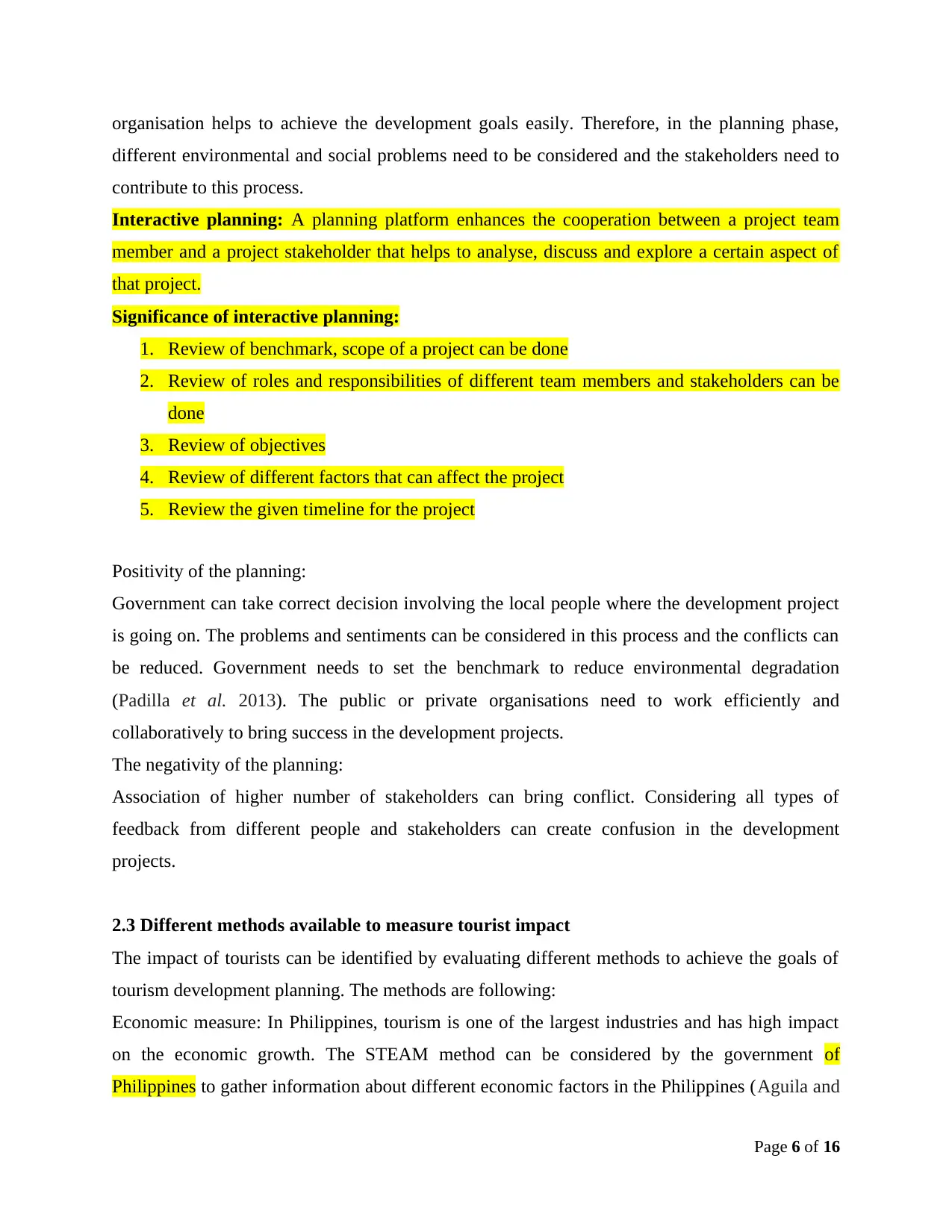
organisation helps to achieve the development goals easily. Therefore, in the planning phase,
different environmental and social problems need to be considered and the stakeholders need to
contribute to this process.
Interactive planning: A planning platform enhances the cooperation between a project team
member and a project stakeholder that helps to analyse, discuss and explore a certain aspect of
that project.
Significance of interactive planning:
1. Review of benchmark, scope of a project can be done
2. Review of roles and responsibilities of different team members and stakeholders can be
done
3. Review of objectives
4. Review of different factors that can affect the project
5. Review the given timeline for the project
Positivity of the planning:
Government can take correct decision involving the local people where the development project
is going on. The problems and sentiments can be considered in this process and the conflicts can
be reduced. Government needs to set the benchmark to reduce environmental degradation
(Padilla et al. 2013). The public or private organisations need to work efficiently and
collaboratively to bring success in the development projects.
The negativity of the planning:
Association of higher number of stakeholders can bring conflict. Considering all types of
feedback from different people and stakeholders can create confusion in the development
projects.
2.3 Different methods available to measure tourist impact
The impact of tourists can be identified by evaluating different methods to achieve the goals of
tourism development planning. The methods are following:
Economic measure: In Philippines, tourism is one of the largest industries and has high impact
on the economic growth. The STEAM method can be considered by the government of
Philippines to gather information about different economic factors in the Philippines (Aguila and
Page 6 of 16
different environmental and social problems need to be considered and the stakeholders need to
contribute to this process.
Interactive planning: A planning platform enhances the cooperation between a project team
member and a project stakeholder that helps to analyse, discuss and explore a certain aspect of
that project.
Significance of interactive planning:
1. Review of benchmark, scope of a project can be done
2. Review of roles and responsibilities of different team members and stakeholders can be
done
3. Review of objectives
4. Review of different factors that can affect the project
5. Review the given timeline for the project
Positivity of the planning:
Government can take correct decision involving the local people where the development project
is going on. The problems and sentiments can be considered in this process and the conflicts can
be reduced. Government needs to set the benchmark to reduce environmental degradation
(Padilla et al. 2013). The public or private organisations need to work efficiently and
collaboratively to bring success in the development projects.
The negativity of the planning:
Association of higher number of stakeholders can bring conflict. Considering all types of
feedback from different people and stakeholders can create confusion in the development
projects.
2.3 Different methods available to measure tourist impact
The impact of tourists can be identified by evaluating different methods to achieve the goals of
tourism development planning. The methods are following:
Economic measure: In Philippines, tourism is one of the largest industries and has high impact
on the economic growth. The STEAM method can be considered by the government of
Philippines to gather information about different economic factors in the Philippines (Aguila and
Page 6 of 16
⊘ This is a preview!⊘
Do you want full access?
Subscribe today to unlock all pages.

Trusted by 1+ million students worldwide

Ragot, 2014). This method is helpful to track the tourists, events and more. Based on the
information, government can invest in development of infrastructure. The citizen of Philippines
also provides information using this system. The complex process of calculation is the main
limitation of this system.
Social measure: The social impact due to development of tourism industry is essential to reduce
any conflict. However, the social information is hard to analyse for its qualitative nature. The
Survey, interviews are the method to get the information related to social impact which are
adopted by the government of Philippines. The HDI, GDP can also be considered to judge the
impact and the government of Philippines can take future steps accordingly.
Environmental measure: According to the case study, environmental degradation is happened
due to human and it needs to be reduced by tracking the damage. Environmental Impact
Assessment (EIA) is the method to gather data and calculate the damage of a selected place,
which can be used by government of Philippines. However, the calculation of damage on
environment cannot be done completely for its unpredictable nature, which can prevent the
development activities (Aquino et al. 2017). However, the government of Philippines can focus
on approximate result of the calculation and bring changes accordingly.
Task 3
3.1 Introduction of the concept of sustainability in tourism development
Sustainable tourism development
Refer to poster
3.2 Factors that may prevent/ hinder sustainable tourism development
Factors that can prevent the sustainable development
Refer to poster
3.3 Different stages of planning for sustainability
Refer to leaflet
Page 7 of 16
information, government can invest in development of infrastructure. The citizen of Philippines
also provides information using this system. The complex process of calculation is the main
limitation of this system.
Social measure: The social impact due to development of tourism industry is essential to reduce
any conflict. However, the social information is hard to analyse for its qualitative nature. The
Survey, interviews are the method to get the information related to social impact which are
adopted by the government of Philippines. The HDI, GDP can also be considered to judge the
impact and the government of Philippines can take future steps accordingly.
Environmental measure: According to the case study, environmental degradation is happened
due to human and it needs to be reduced by tracking the damage. Environmental Impact
Assessment (EIA) is the method to gather data and calculate the damage of a selected place,
which can be used by government of Philippines. However, the calculation of damage on
environment cannot be done completely for its unpredictable nature, which can prevent the
development activities (Aquino et al. 2017). However, the government of Philippines can focus
on approximate result of the calculation and bring changes accordingly.
Task 3
3.1 Introduction of the concept of sustainability in tourism development
Sustainable tourism development
Refer to poster
3.2 Factors that may prevent/ hinder sustainable tourism development
Factors that can prevent the sustainable development
Refer to poster
3.3 Different stages of planning for sustainability
Refer to leaflet
Page 7 of 16
Paraphrase This Document
Need a fresh take? Get an instant paraphrase of this document with our AI Paraphraser
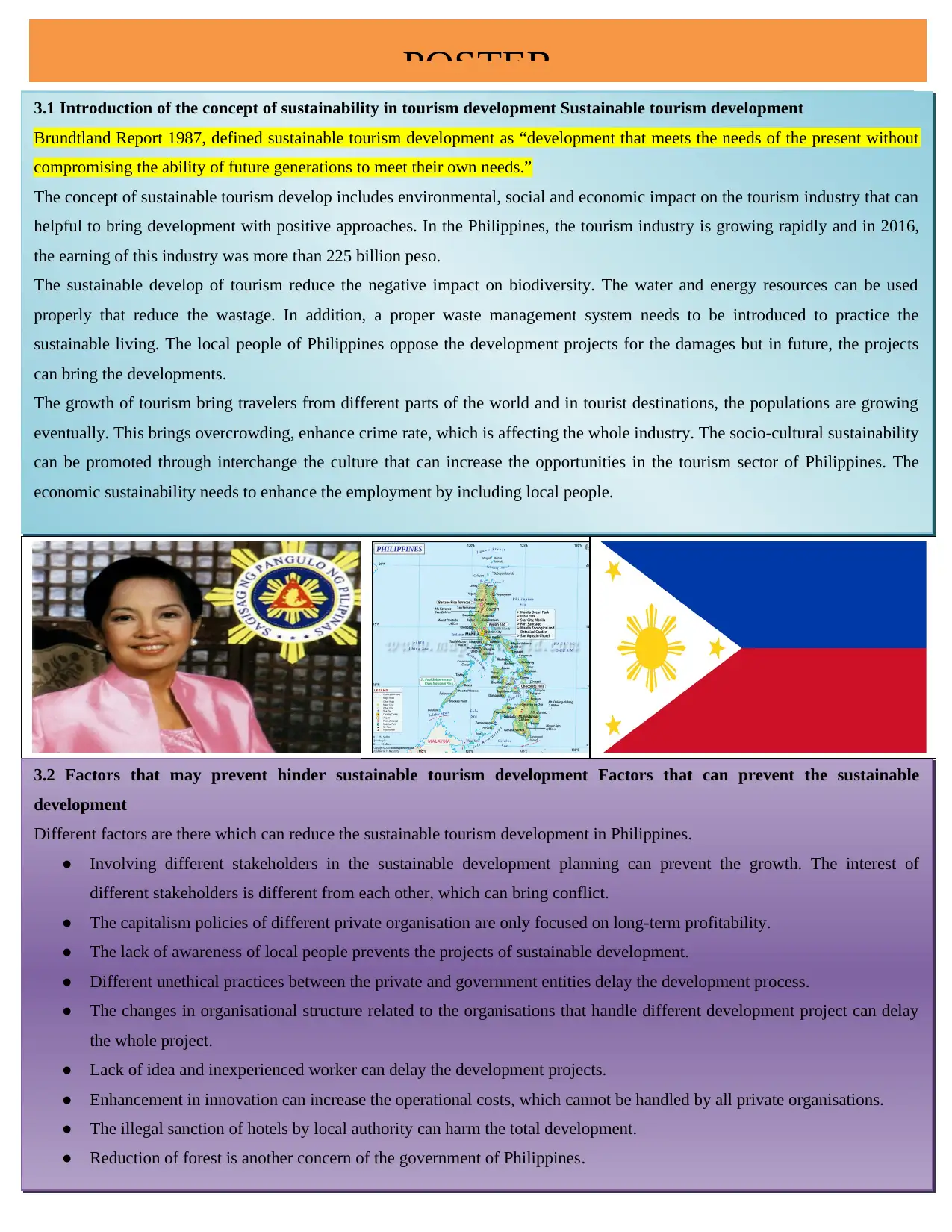
Page 8 of 16
POSTER
3.1 Introduction of the concept of sustainability in tourism development Sustainable tourism development
Brundtland Report 1987, defined sustainable tourism development as “development that meets the needs of the present without
compromising the ability of future generations to meet their own needs.”
The concept of sustainable tourism develop includes environmental, social and economic impact on the tourism industry that can
helpful to bring development with positive approaches. In the Philippines, the tourism industry is growing rapidly and in 2016,
the earning of this industry was more than 225 billion peso.
The sustainable develop of tourism reduce the negative impact on biodiversity. The water and energy resources can be used
properly that reduce the wastage. In addition, a proper waste management system needs to be introduced to practice the
sustainable living. The local people of Philippines oppose the development projects for the damages but in future, the projects
can bring the developments.
The growth of tourism bring travelers from different parts of the world and in tourist destinations, the populations are growing
eventually. This brings overcrowding, enhance crime rate, which is affecting the whole industry. The socio-cultural sustainability
can be promoted through interchange the culture that can increase the opportunities in the tourism sector of Philippines. The
economic sustainability needs to enhance the employment by including local people.
3.2 Factors that may prevent hinder sustainable tourism development Factors that can prevent the sustainable
development
Different factors are there which can reduce the sustainable tourism development in Philippines.
● Involving different stakeholders in the sustainable development planning can prevent the growth. The interest of
different stakeholders is different from each other, which can bring conflict.
● The capitalism policies of different private organisation are only focused on long-term profitability.
● The lack of awareness of local people prevents the projects of sustainable development.
● Different unethical practices between the private and government entities delay the development process.
● The changes in organisational structure related to the organisations that handle different development project can delay
the whole project.
● Lack of idea and inexperienced worker can delay the development projects.
● Enhancement in innovation can increase the operational costs, which cannot be handled by all private organisations.
● The illegal sanction of hotels by local authority can harm the total development.
● Reduction of forest is another concern of the government of Philippines.
POSTER
3.1 Introduction of the concept of sustainability in tourism development Sustainable tourism development
Brundtland Report 1987, defined sustainable tourism development as “development that meets the needs of the present without
compromising the ability of future generations to meet their own needs.”
The concept of sustainable tourism develop includes environmental, social and economic impact on the tourism industry that can
helpful to bring development with positive approaches. In the Philippines, the tourism industry is growing rapidly and in 2016,
the earning of this industry was more than 225 billion peso.
The sustainable develop of tourism reduce the negative impact on biodiversity. The water and energy resources can be used
properly that reduce the wastage. In addition, a proper waste management system needs to be introduced to practice the
sustainable living. The local people of Philippines oppose the development projects for the damages but in future, the projects
can bring the developments.
The growth of tourism bring travelers from different parts of the world and in tourist destinations, the populations are growing
eventually. This brings overcrowding, enhance crime rate, which is affecting the whole industry. The socio-cultural sustainability
can be promoted through interchange the culture that can increase the opportunities in the tourism sector of Philippines. The
economic sustainability needs to enhance the employment by including local people.
3.2 Factors that may prevent hinder sustainable tourism development Factors that can prevent the sustainable
development
Different factors are there which can reduce the sustainable tourism development in Philippines.
● Involving different stakeholders in the sustainable development planning can prevent the growth. The interest of
different stakeholders is different from each other, which can bring conflict.
● The capitalism policies of different private organisation are only focused on long-term profitability.
● The lack of awareness of local people prevents the projects of sustainable development.
● Different unethical practices between the private and government entities delay the development process.
● The changes in organisational structure related to the organisations that handle different development project can delay
the whole project.
● Lack of idea and inexperienced worker can delay the development projects.
● Enhancement in innovation can increase the operational costs, which cannot be handled by all private organisations.
● The illegal sanction of hotels by local authority can harm the total development.
● Reduction of forest is another concern of the government of Philippines.
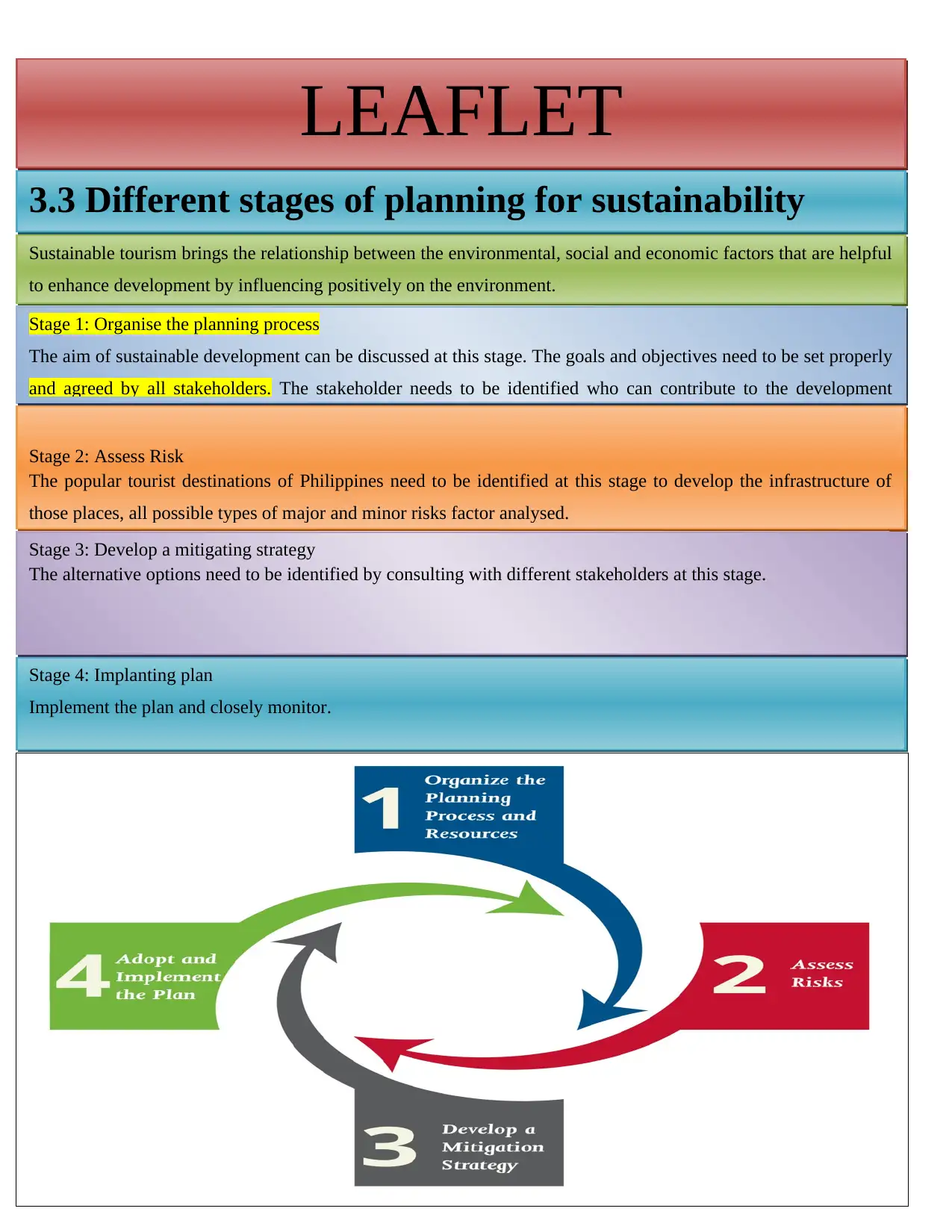
Page 9 of 16
LEAFLET
3.3 Different stages of planning for sustainability
Sustainable tourism brings the relationship between the environmental, social and economic factors that are helpful
to enhance development by influencing positively on the environment.
Stage 1: Organise the planning process
The aim of sustainable development can be discussed at this stage. The goals and objectives need to be set properly
and agreed by all stakeholders. The stakeholder needs to be identified who can contribute to the development
Stage 4: Implanting plan
Implement the plan and closely monitor.
Stage 2: Assess Risk
The popular tourist destinations of Philippines need to be identified at this stage to develop the infrastructure of
those places, all possible types of major and minor risks factor analysed.
Stage 3: Develop a mitigating strategy
The alternative options need to be identified by consulting with different stakeholders at this stage.
LEAFLET
3.3 Different stages of planning for sustainability
Sustainable tourism brings the relationship between the environmental, social and economic factors that are helpful
to enhance development by influencing positively on the environment.
Stage 1: Organise the planning process
The aim of sustainable development can be discussed at this stage. The goals and objectives need to be set properly
and agreed by all stakeholders. The stakeholder needs to be identified who can contribute to the development
Stage 4: Implanting plan
Implement the plan and closely monitor.
Stage 2: Assess Risk
The popular tourist destinations of Philippines need to be identified at this stage to develop the infrastructure of
those places, all possible types of major and minor risks factor analysed.
Stage 3: Develop a mitigating strategy
The alternative options need to be identified by consulting with different stakeholders at this stage.
⊘ This is a preview!⊘
Do you want full access?
Subscribe today to unlock all pages.

Trusted by 1+ million students worldwide

Task 4
4.1 Methods of resolving a conflict of interests to ensure the future wellbeing of a
developing tourism destination
Association of different stakeholders can bring confusion and conflict in a project. The conflict
of interest of different organisations needs to be reduced in order to plan the development project
properly. According to the case study, there is negative social and environmental cost during the
development of tourism in the Philippines. The social problem arises while the local people
prevents the development projects for enhancing problems in social life.
Negotiation: In order to reduce the conflict between the different stakeholders and with local
people, negotiations needed. The parties involved in negotiation process needs to have clear
interaction with different stakeholder and local people (Bunakov et al. 2015). The
communication process needs to involve fair deal, which can provide benefits for all. It is helpful
to identify the negativities more clearly and implement strategies.
Mediation: Different parties actively participate to resolve the conflicts and bring mutually
acceptable agreements. As for instance, the local governmental bodies of Philippines can provide
job opportunities to the local people. This is helpful to reduce the misunderstanding and
conflicts.
Interpersonal relationship: The government of Philippines can develop interpersonal relationship
with the stakeholders. The government can attach the local people in their differen development
projects that help them to understand the significance of those more properly and conflicts can be
reduced.
4.2 Implications of balancing supply and demand
At the end of 2016, the international visitors in Philippines have reduced by 28 percent which
reduces the earning from 21.97 billion pesos to 15.69 billion pesos. Tourists from USA, Korea
and Japan are contributed mostly to the earning related to tourism. The expenditure is
approximately 42.8 million peso, 102.88 million pesos and 42.1 million pesos for the USA,
Korea and Japan respectively. From Asian countries, 69 percent visitors are gathered in the
Philippines in 2016. The earning from tourism industry contributes 10 percent to the total GDP
of Philippines and provides more than 4 million jobs across the country (Larionova et al. 2017).
Page 10 of 16
4.1 Methods of resolving a conflict of interests to ensure the future wellbeing of a
developing tourism destination
Association of different stakeholders can bring confusion and conflict in a project. The conflict
of interest of different organisations needs to be reduced in order to plan the development project
properly. According to the case study, there is negative social and environmental cost during the
development of tourism in the Philippines. The social problem arises while the local people
prevents the development projects for enhancing problems in social life.
Negotiation: In order to reduce the conflict between the different stakeholders and with local
people, negotiations needed. The parties involved in negotiation process needs to have clear
interaction with different stakeholder and local people (Bunakov et al. 2015). The
communication process needs to involve fair deal, which can provide benefits for all. It is helpful
to identify the negativities more clearly and implement strategies.
Mediation: Different parties actively participate to resolve the conflicts and bring mutually
acceptable agreements. As for instance, the local governmental bodies of Philippines can provide
job opportunities to the local people. This is helpful to reduce the misunderstanding and
conflicts.
Interpersonal relationship: The government of Philippines can develop interpersonal relationship
with the stakeholders. The government can attach the local people in their differen development
projects that help them to understand the significance of those more properly and conflicts can be
reduced.
4.2 Implications of balancing supply and demand
At the end of 2016, the international visitors in Philippines have reduced by 28 percent which
reduces the earning from 21.97 billion pesos to 15.69 billion pesos. Tourists from USA, Korea
and Japan are contributed mostly to the earning related to tourism. The expenditure is
approximately 42.8 million peso, 102.88 million pesos and 42.1 million pesos for the USA,
Korea and Japan respectively. From Asian countries, 69 percent visitors are gathered in the
Philippines in 2016. The earning from tourism industry contributes 10 percent to the total GDP
of Philippines and provides more than 4 million jobs across the country (Larionova et al. 2017).
Page 10 of 16
Paraphrase This Document
Need a fresh take? Get an instant paraphrase of this document with our AI Paraphraser
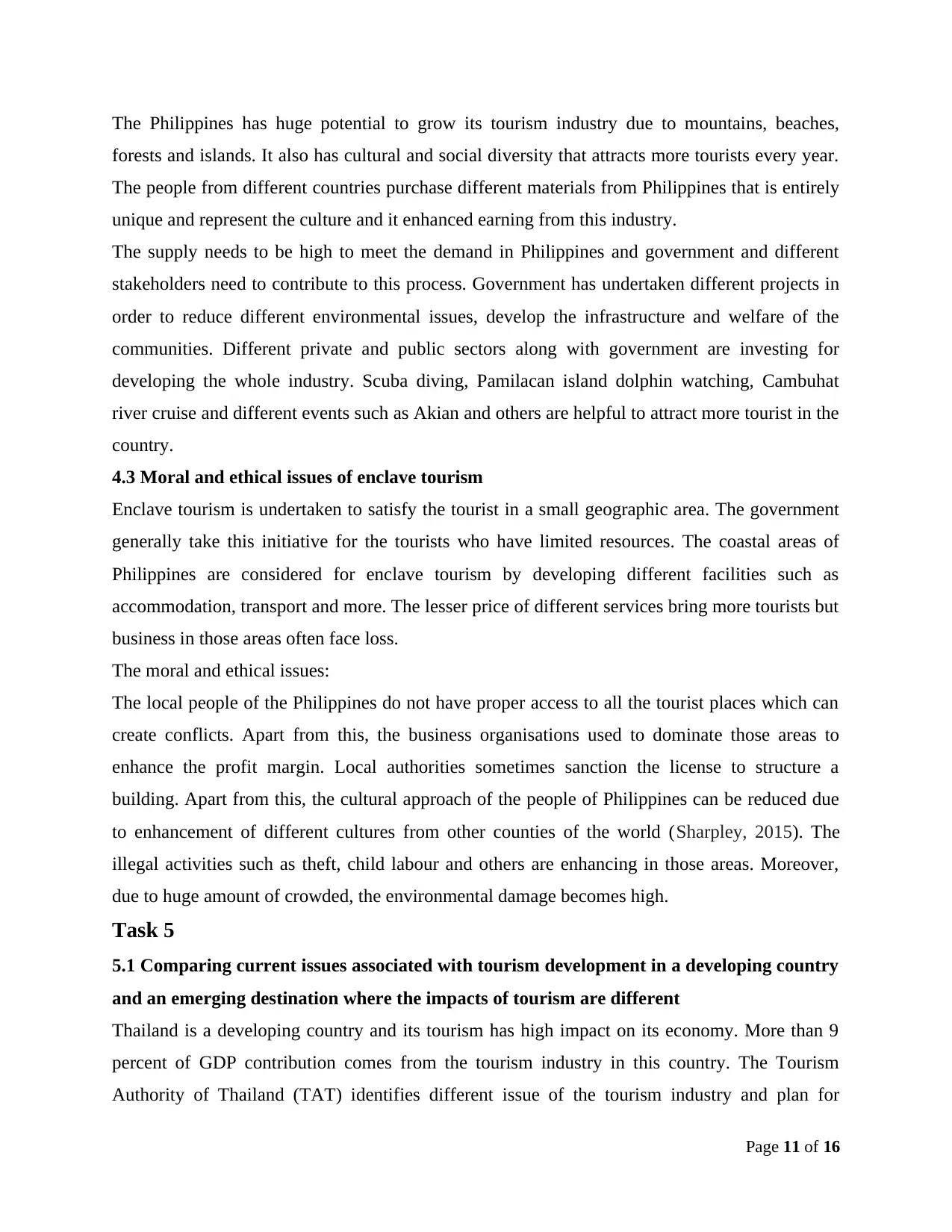
The Philippines has huge potential to grow its tourism industry due to mountains, beaches,
forests and islands. It also has cultural and social diversity that attracts more tourists every year.
The people from different countries purchase different materials from Philippines that is entirely
unique and represent the culture and it enhanced earning from this industry.
The supply needs to be high to meet the demand in Philippines and government and different
stakeholders need to contribute to this process. Government has undertaken different projects in
order to reduce different environmental issues, develop the infrastructure and welfare of the
communities. Different private and public sectors along with government are investing for
developing the whole industry. Scuba diving, Pamilacan island dolphin watching, Cambuhat
river cruise and different events such as Akian and others are helpful to attract more tourist in the
country.
4.3 Moral and ethical issues of enclave tourism
Enclave tourism is undertaken to satisfy the tourist in a small geographic area. The government
generally take this initiative for the tourists who have limited resources. The coastal areas of
Philippines are considered for enclave tourism by developing different facilities such as
accommodation, transport and more. The lesser price of different services bring more tourists but
business in those areas often face loss.
The moral and ethical issues:
The local people of the Philippines do not have proper access to all the tourist places which can
create conflicts. Apart from this, the business organisations used to dominate those areas to
enhance the profit margin. Local authorities sometimes sanction the license to structure a
building. Apart from this, the cultural approach of the people of Philippines can be reduced due
to enhancement of different cultures from other counties of the world (Sharpley, 2015). The
illegal activities such as theft, child labour and others are enhancing in those areas. Moreover,
due to huge amount of crowded, the environmental damage becomes high.
Task 5
5.1 Comparing current issues associated with tourism development in a developing country
and an emerging destination where the impacts of tourism are different
Thailand is a developing country and its tourism has high impact on its economy. More than 9
percent of GDP contribution comes from the tourism industry in this country. The Tourism
Authority of Thailand (TAT) identifies different issue of the tourism industry and plan for
Page 11 of 16
forests and islands. It also has cultural and social diversity that attracts more tourists every year.
The people from different countries purchase different materials from Philippines that is entirely
unique and represent the culture and it enhanced earning from this industry.
The supply needs to be high to meet the demand in Philippines and government and different
stakeholders need to contribute to this process. Government has undertaken different projects in
order to reduce different environmental issues, develop the infrastructure and welfare of the
communities. Different private and public sectors along with government are investing for
developing the whole industry. Scuba diving, Pamilacan island dolphin watching, Cambuhat
river cruise and different events such as Akian and others are helpful to attract more tourist in the
country.
4.3 Moral and ethical issues of enclave tourism
Enclave tourism is undertaken to satisfy the tourist in a small geographic area. The government
generally take this initiative for the tourists who have limited resources. The coastal areas of
Philippines are considered for enclave tourism by developing different facilities such as
accommodation, transport and more. The lesser price of different services bring more tourists but
business in those areas often face loss.
The moral and ethical issues:
The local people of the Philippines do not have proper access to all the tourist places which can
create conflicts. Apart from this, the business organisations used to dominate those areas to
enhance the profit margin. Local authorities sometimes sanction the license to structure a
building. Apart from this, the cultural approach of the people of Philippines can be reduced due
to enhancement of different cultures from other counties of the world (Sharpley, 2015). The
illegal activities such as theft, child labour and others are enhancing in those areas. Moreover,
due to huge amount of crowded, the environmental damage becomes high.
Task 5
5.1 Comparing current issues associated with tourism development in a developing country
and an emerging destination where the impacts of tourism are different
Thailand is a developing country and its tourism has high impact on its economy. More than 9
percent of GDP contribution comes from the tourism industry in this country. The Tourism
Authority of Thailand (TAT) identifies different issue of the tourism industry and plan for
Page 11 of 16

sustainable growth in the country. The theme of marketing the tourism in Thailand is "Amazing
Thailand".
According to different research, Thailand is an attractive destination for tourists from its different
environment and cultural diversity (Mowforth and Munt, 2015). However, a number of
drawbacks are there that needs to be considered by the government to enhance the development.
The Philippines is also an attractive destination for tourists from all over the word. However, a
different internal problem such as poverty, unemployment hampers the sustainable development
of this industry.
The issues are following for both countries:
Impact Thailand Philippines
Environmental The pollution level is high in
Thailand for growing
population, deforestation and
more. High numbers of tourist
are the reason for destroying
the coral reefs that reduce the
balance of ecosystem. The
soil erosion is the cause of
deforestation. Apart from this,
high population in different
tourist destination enhance
the problem of waste (Berger,
2014).
Enhancement of tourist
increases the environmental
degradation. The
deforestation, soil erosion and
destruction of coral reefs are
reducing the balance of
environment.
Social and cultural Enhancement of tourist brings
social conflict in Thailand.
The strategies of different
hospitality industry are
implemented to satisfy the
tourist and it decreasing the
cultural significance of
People from different parts of
the world come to Philippines
for tourism purpose and mix
with the local culture. It
creates different issues with
local people and different
unethical practices such as
Page 12 of 16
Thailand".
According to different research, Thailand is an attractive destination for tourists from its different
environment and cultural diversity (Mowforth and Munt, 2015). However, a number of
drawbacks are there that needs to be considered by the government to enhance the development.
The Philippines is also an attractive destination for tourists from all over the word. However, a
different internal problem such as poverty, unemployment hampers the sustainable development
of this industry.
The issues are following for both countries:
Impact Thailand Philippines
Environmental The pollution level is high in
Thailand for growing
population, deforestation and
more. High numbers of tourist
are the reason for destroying
the coral reefs that reduce the
balance of ecosystem. The
soil erosion is the cause of
deforestation. Apart from this,
high population in different
tourist destination enhance
the problem of waste (Berger,
2014).
Enhancement of tourist
increases the environmental
degradation. The
deforestation, soil erosion and
destruction of coral reefs are
reducing the balance of
environment.
Social and cultural Enhancement of tourist brings
social conflict in Thailand.
The strategies of different
hospitality industry are
implemented to satisfy the
tourist and it decreasing the
cultural significance of
People from different parts of
the world come to Philippines
for tourism purpose and mix
with the local culture. It
creates different issues with
local people and different
unethical practices such as
Page 12 of 16
⊘ This is a preview!⊘
Do you want full access?
Subscribe today to unlock all pages.

Trusted by 1+ million students worldwide
1 out of 16
Related Documents
Your All-in-One AI-Powered Toolkit for Academic Success.
+13062052269
info@desklib.com
Available 24*7 on WhatsApp / Email
![[object Object]](/_next/static/media/star-bottom.7253800d.svg)
Unlock your academic potential
Copyright © 2020–2026 A2Z Services. All Rights Reserved. Developed and managed by ZUCOL.





